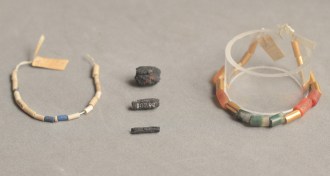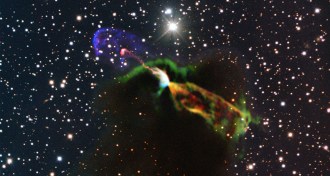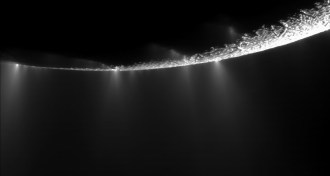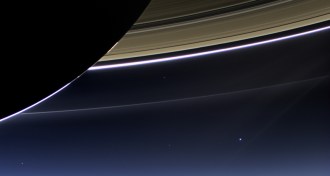Space
Sign up for our newsletter
We summarize the week's scientific breakthroughs every Thursday.
-
 Astronomy
Astronomy‘Space beads’ push back origins of iron working
Ancient Egyptians used advanced techniques to make beads out of 'metal from the sky.'
By Bruce Bower -
 Astronomy
AstronomyTo determine stars’ physical traits, Kepler sees the light
Measuring stellar brightness can yield useful estimates of stars' size and evolutionary stage, and help in the hunt for planets.
By Andrew Grant -
 Astronomy
AstronomyPictures of young star show unusual outbursts
Ejections from stellar newborn move faster and in different directions than astronomers thought.
-
 Planetary Science
Planetary ScienceNASA gives up on fixing Kepler
Space telescope’s days as a premier planet hunter are over.
By Andrew Grant -
 Space
SpaceBelief in multiverse requires exceptional vision
If you can’t see it, it doesn’t exist. That’s an old philosophy, one that many scientists swallowed whole. But as Ziva David of NCIS would say, it’s total salami. After all, you can’t see bacteria and viruses, but they can still kill you. Yet some scientists still invoke that philosophy to deny the scientific status […]
-
 Astronomy
AstronomyMagnetic field of black hole measured
Pulsar near Milky Way’s center makes first assessment of this type possible.
By Andrew Grant -
 Space
SpaceLong the stuff of fantasy, wormholes may be coming soon to a telescope near you
For decades now, black holes have been the rock stars of popular astrophysics, both fact and fiction. Physicists rely on them to explain all sorts of mysterious astrophenomena, and black holes have been essential plot devices in various films, from Star Trek (2009) to Galaxy Quest (1999) to (obviously) The Black Hole (1979). But black […]
-
 Planetary Science
Planetary ScienceSaturn’s tides drive icy moon’s plumes
Enceladus' chilly jets ebb and flow in time with its planet's tug.
-
 Planetary Science
Planetary ScienceCassini photo puts Earth in perspective
Probe captures planet from 1.4 billion kilometers away.
By Andrew Grant -
 Space
SpaceMars meteorite reveals its age
Long difficult to estimate, date of space rocks' formation emerges with new technique.
By Andrew Grant -
 Cosmology
CosmologyGold seen in neutron star collision debris
Material ejected in gamma-ray bursts may be a main source of the heavy elements.
By Erin Wayman -
 Astronomy
AstronomyMilky Way’s black hole pulling in gas cloud
Galaxy's maw begins to tear apart and change the velocity of an approaching object.
By Andrew Grant